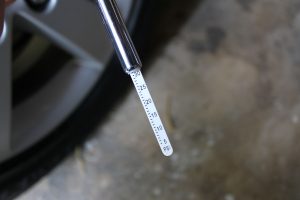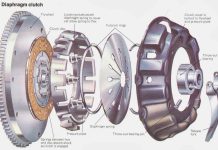You don’t have to be an architect to know there’s something wrong with the Leaning Tower of Pisa – which isn’t supposed to be leaning.
The same kind of troubleshooting can be applied to your car. It’s not necessary to be a mechanic to notice things that don’t look right – in time to call them to the attention of a mechanic – before something minor turns into something major.
I was texting with a friend about this the other day.
She recently bought a used car. It has an automatic transmission. She didn’t know about checking the fluid – color as well as level, plus smell. These three checks can tell you a lot about the condition of an automatic transmission.
Low fluid suggests a leak, as transmissions (unlike engines, which burn a little engine oil as part of their normal operation) aren’t supposed to consume automatic transmission fluid (ATF) and should not require periodic topping off. The level on the dipstick should remain at the same level – Full – consistently.
If yours ever reads low, it’s a good bet there’s a leaky seal somewhere that is bound to get worse. And more than a mess is at issue. You could croak the transmission – huge expense – over a relatively minor leak that could have been fixed for probably not much. Automatic transmissions are very sensitive to low fluid levels; major damage can occur very quickly. And you might not get the slightest warning before it’s Too Late because many cars do not have a warning light or buzzer to let you know the ATF level’s low. Which is why it is important to check it manually, once a month – at least.
And right now, if you ever notice a red-orange drip or puddle underneath the car.
The ATF should be a cherry-red, orange (sometimes, blue) color – depending on the brand. It should never be black or brown. If it is – and it’s a used car you’re looking at and you haven’t bought it yet – don’t. If it’s your car, prepare for an expensive transmission rebuild.
Black/brown fluid – which will often smell burned, too – is cooked fluid, not just dirty fluid. It indicates the transmission overheated – and that is death to automatics. Even if it’s only brief overheating. Automatics are hugely sensitive to this – much more so than an engine.
It may be an issue with the cooling lines or some other thing. But something big isn’t right, unfortunately. Prepare to dig deep.
A car should also sit right – and not lean, like the Tower of Pisa. 
You have probably found yourself driving behind a car that does lean. It tilts to the left – or the right. Or it sags in back (possibly, just because it’s overloaded). This sort of thing is obvious to other drivers – not so much to the person driving the listing car.
Who could be you.
Leaning/sagging can be due to relatively minor and easily fixable things such as a bad shock/strut or (fingers-crossed-it’s-not) something major and very expensive to fix like a bad adjustable/air suspension or (even worse) structural damage to the vehicle’s chassis due to an accident or rust.
Take the prospect to a flat and empty parking lot where you can park, get out, and look at the car from all angles from about 20 yards away. It should sit level.
It’s not a bad idea to have a friend drive your car and you follow him in another. You’ll get a view of your car from the outside and while it’s moving – which is a view you probably only rarely get to see. In addition to looking for levelness, you will want to have a look at the wheels/tires – and make sure they line up true, front-to-year. If the car looks like it’s stagger-stepping to one side… well, you’ve got a problem. 
If it’s a used car you’re looking at, it is critical to both your wallet and your safety to do all this before you commit to buying the thing so as to not inherit someone else’s Big Money Troubles.
Some other things often can’t be seen but are important to verify.
Yes, it’s true most new cars have tire pressure monitors. They work like the government that mandated them: Sometimes – and often, not well.
Do not rely on them exclusively.
I test-drive brand new cars with brand new tires (and brand-new tire pressure monitors) and have found that the digital dashboard pressure readings are sometimes off by several pounds. There is still no substitute for manually verifying tire pressure using a stick gauge. Especially if your car has short sidewall “sport” tires, which can look full but may be almost flat. This has happened to me, with a brand-new press car. And a sporty car with sport tires – one or more of them low, but you don’t know it – can be a Weird and Dangerous car to drive. 
If this can happen in a brand-new car press car, it is certainly possible in your not new car that maybe has 89,000 miles on it.
Remember what Reagan said about the Russkies? Trust – but verify. It’s the same with tire pressure. It’s smart policy to break out the stick once a month. No matter what the government-mandated digital display says.
If you like what you’ve found here, please consider supporting EPautos.
We depend on you to keep the wheels turning!
Our donate button is here.
If you prefer not to use PayPal, our mailing address is:
EPautos
721 Hummingbird Lane SE
Copper Hill, VA 24079
PS: EPautos stickers are free to those who send in $20 or more to support the site. 













Thanks for your good advice. plus you are all pretty funny…
(I’m new here.). Truck has a birthday in April – 20 years – and now I need you like crazy! (Heading outside now in the dark to do rectal exam…)
My pleasure, HG!
Welcome to EPautos!
When looking at a used car, also pop the hood & check any of the suspension parts you can see. Pay attention to the upper control arm bushings. If they are cracked, or have shrunk & pulled away from the control arm, the rest of the front suspension is probably in the same bad shape. Check the wear on the tires. If one edge is worn more than the other, the car needs at least an alignment. Check the spare tire too. Often, a person selling a car will awap a spare for a worn front tire. If you can crawl under the front of the car, grab and twist and shake various front suspension parrts (sway bars, tie rods, etc.). Loose is bad.
I needed some winter floor mats for my Audi and a friend had some nice Honda mats with the word Honda stitched into them,they fit so I used them. The friend said “now you have part Honda n part Audi, you are driving a Howdy (haudi)” I thought it was funny.
My cousin had a car that leaned badly when he was in college and broke. He named the car Eileen.
Hi Rich,
High school buddy had a Nova with rust so bad the right rear spring perch migrated to inside the trunk… it made the car walk funny…
I think there was a design issue with the fourth gen Novas in the late 70’s. Every single one that I ever saw from behind tracked sideways, even when they were fairly new.
My ’75 Dodge Dart rusted out (besides everywhere) where the torsion bar fastened to the front frame on the passenger side; I slit an old tire and wrapped a few lengths of the rubber around the arm to sort of level it out where otherwise it was metal on metal. Drove it that way for almost another year before the driver’s side let go, and that’s when I junked the car.
Something about 70’s cars, they were all rust buckets.
And don’t forget the Ford Escorts and their Mercury Lynx clones who nearly all ‘squatted’ in the rear suspension once reaching a few years of age.
I kind of liked those cars. My sister bought a brand new 85 Lynx, drove it to the ground and then sold it to me for a couple hundred bucks in the mid 90’s. I gave it to my kids to drive to school and back. It was full of holes, rotted floor pans, fenders flappin’ in the breeze, but I’ll tell ya what, it just ran and ran forever. Never had a single mechanical problem whatsoever. And I know my kids beat the shit outta that car, but it kept going like the energizer bunny.
I haven’t ever had a car lean, or have bad springs, one of the few things I haven’t had go bad. Just a tie rod once. In a gas station parking lot no less. Left wheel pointing left, right wheel pointing right. Looks so weird ha ha.
When I was working in one place many years ago, I got stuck in the warehouse one day (tiny company, I was the graphic designer!) a trucker came in very overloaded. The springs on the trailer were pushed all the way down, rubbing most certainly. How he got that truck moving, I don’t know (fairly new driver). I bring up the forklift, and try to pick up the first pallet, and I come off the ground on the back! What does this thing weigh? I look at the manifest and my dear ol’ boss had put the decimal point in the wrong place. Instead of a load of 8,000 pounds, that trailer had 80,000!
Had to run down the street and borrow a bigger folklift from one of the other companies in the industrial park, and even that one was at the limits. But the springs were making horrid noises as I took the weight off them.
One of the best and quickest indicators of a car’s engine’s health, is to stick your finger in the exhaust pipe (Best done when it’s not 400*F …) and kinda swab around the inside wall of the pipe. If your finger comes out clean, you’ve got a healthy engine. A little soot? Might be running rich, or burning a little oil- warrants further scrutiny. Thick powdery or wet gooey residue? Major problems, like a blown head gasket or heavily-worn engine/burning lots of oil. Walk away.
Also, a whiff of the exhaust as the car is running can tell you a lot. If you smell gasoline or antifreeze or oil….it’s got problems. (Neighbor comes over one day to show me the 15 year-old Jap car he just bought. As I’m walking around it, i smell antifreeze- I say “Uh-oh…think it’s got a blown head gasket”….and sure enough, a month later he figures it out!)
And a listen at the pipe while the car is running. A hollow “glug-glug”: Head gasket/cracked head/intake manifold gasket/etc. Popping, spitting or skipping = valve trouble.
You can tell so much just from the exhaust- it’s like a rectal probe for cars- but I never see anybody doing this simple check- not even pros at auctions. I think in all my years, I’ve seen ONE person doing it once. Paying attention to the exhaust has saved me LOTS of time, and has saved my butt/wallet MANY times.
Be a car proctologist!
Also when test driving a car, go about 30 or so, then punch it. Look in one of the side mirrors at the exhaust. It should be fairly clean. A little black soot is okay, but blue smoke is bad (piston rings bad). Next, put it in a lower gear, (say D2 on an automatic), and go fast enough in that gear such that the engine is revving pretty high while your moving. Then let off the gas and coast in the low gear. Again, look for the exhaust. It again should not be blue smoke. If it is then oil is getting past the valves. If it backfires while doing this, it is running lean and needs a tune up.
“If it backfires while doing this, it is running lean and needs a tune up.”
or it has an exhaust leak…
not to mention most cars made in the e.f.i. era have a deceleration fuel cut off routine programmed into the ecm. they’re supposed to go lean when you lift the throttle.
never a bad idea to pull a few spark plugs out and have a look. oil deposits and overly rich or lean crusing mixture will be readily apparent.
Heh, yeah, I was test driving a diesel van once, and it seemed quite decent for the price, until I looked in the mirror when punching it a little, and saw the plume of blue smoke! (NOT “rolling coal” like the new-fangled trucks- this was an old 6.9 mechaically-injected *real* diesel)
Maybe it’s a blu-tech diesel?
That Lexus GX470 (same as mine) has either a blown rear suspension airbag, or one of the two auto-height sensors is bad/out of adjustment.
New airbags (should be replaced in pairs) will be about $1200-1400. New height sensor (should only need to replace the bad one) will be about $500. These are dealer prices. Parts cost is about half that, if you’re handy and have the tools.
The early versions of that SUV (again, like mine) are only worth about $8000-10000 now (depreciation on a $60k luxury vehicle can sometimes work in your favor). Is it worth putting that kind of money into a repair for a car you’re only thinking about buying? Doubtful. If you already own it, yes. Because Toyotas will drive forever if you maintain them. I hope to get 3 more years out of mine, taking it to 16 years old.
BTW, stick gauges are inaccurate. The cheapo digital ones are surprisingly good. Better than the dial gauges, even.